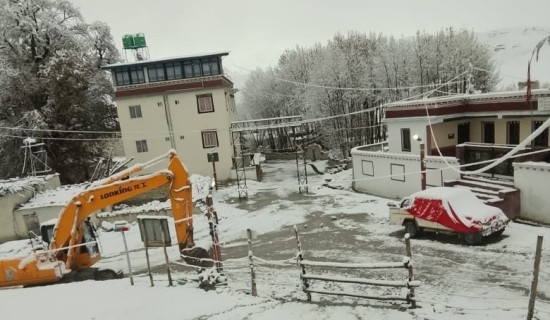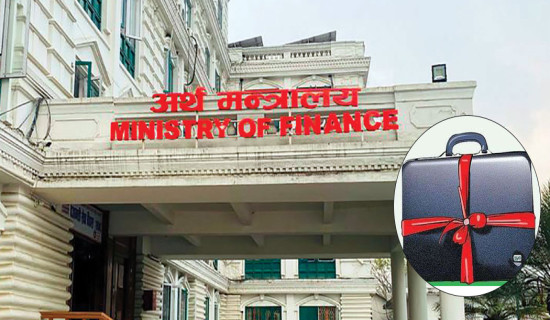- Wednesday, 29 October 2025
Once successful in Nepal, bio-gas could still be alternative to LP gas
Kathmandu, Dec. 24:The 15th Periodic Plan of Nepal implemented in the fiscal year (FY) 2019/20 had envisaged installing 200,000 domestic bio-gas (DBG) plants.
It also had a plan to replace about 40,000 tonnes of Liquefied Petroleum Gas (LPG) through the installation of 500 large biogas plants.
The second Nationally Determined Contribution (NDC), 2020 included the same plan with a strategy to install an additional 200,000 household biogas plants and 500 large scale biogas (LBG) plants by 2025.
But the country currently has altogether 419,779 domestic bio-gas plants and 348 large biogas plants.
Meanwhile, the government as well as international donors’ support to bio-gas, which has been one of the major sources of alternative renewable energy and low-carbon technology, has significantly fallen over the years.
Increasing migration to cities, rising construction cost and diminishing support from the donors and government have detrimental impacts on the development and growth of bio-gas plants in Nepal.
Now, the Alternative Energy Promotion Centre (AEPC), the regulatory and implementing agency in the alternative energy sector, has no donors working with it in the bio-gas sector.
Earlier, institutions like the SNV Netherland Development Organisation, World Bank and TFW Germany were providing financial and technical supports to the AEPC.
Nepal once witnessed the construction of about 40,000 bio-gas plants in a year, but now the number has fallen to below 10,000. The AEPC has a target to construct 10,000 plants this fiscal year 2023/24, but is not hopeful of meeting the target.
To meet this target, about Rs. 300 million is needed, but the alternative energy promotion body has the budget of only Rs. 50 million for subsidy.
A success story
Bio-gas sector is one of the areas that Nepal excelled and the country exported its GGC 2017 model in bio-gas plant construction to various African countries as well, said Nawa Raj Dhakal, Executive Director of the AEPC.
About a decade ago, construction of bio-gas plant started revolutionising the rural areas in Nepal by providing clean energy through inexpensive methods. The government provided a good amount of grant covering more than half of the construction cost of the bio-gas plant.
In 1999/2000, a bio-gas plan would cost about Rs. 15,000 and entire money would be subsidised by the government, said Bishnu Prasad Poudel, who worked at a private-biogas company then.
According to him, there was a huge attraction to the bio-bas plant as many families in his work area in Nawalparasi (West) used to rear cattle and work in farms.
But now, the number of families involved in animal husbandry has been significantly reduced, and even in the dairies in villages one can see higher number of people coming to buy milk than to sell it.
Some households in Bardaghat Municipality of Nawalparasi West have abandoned bio-gas plants in their courtyards and LPG cylinder has become a permanent feature of their kitchen. This has been a trend across the country, said Dhakal.
While the cost of construction materials went up significantly after the 2015 earthquake, the government subsidy began decreasing. The government did not show interest in providing subsidy for the construction of bio-gas plants after the development partners pulled their hands out from the project.
Need of 70 per cent subsidy
As per Dhakal, the current government grant covers only 25 to 30 per cent of the total construction cost of the bio-gas plant.
The AEPC had proposed to raise this subsidy to 50 to 60 per cent to promote bio-gas and attract households to this, but it was not approved.
President of Nepal Bio-gas Promotion Association (NBPA), Prakash Subedi, said that the subsidy should be increased up to 70 per cent of the total cost of the plant. Currently, it costs about Rs. 80,000 in average for the construction of a bio-gas plant.
Meanwhile, the bio-gas project of Nepal has been included in the Clean Development Mechanism (CDM) and the country is receiving about Rs. 2 billion a year, said Subedi.
According to the United Nations Framework Convention on Climate Change (UNFCCC), the Clean Development Mechanism (CDM), defined in Article 12 of the Protocol, allows a country with an emission-reduction or emission-limitation commitment under the Kyoto Protocol to implement an emission-reduction project in the developing countries. Such projects can earn saleable certified emission reduction (CER) credits, each equivalent to one tonne of CO2, which can be counted towards meeting Kyoto targets.
According to him, there is a potential of 1 million domestic bio-gas plants in Nepal, but the government should increase the subsidy amount and support in the maintenance of the plants. However, past studies had estimated the national potential for biogas plants in Nepal at 1.9 million. They also suggested that the government subsidy was the major factor behind the success of the bio-gas programme. This fact was supported by the AEPC’s statement in 2021 that the demand in bio-gas plant has going down.
Biogas versus LP gas
The country is spending a large amount of foreign currency in importing the LP gas. According to the statistics of the Department of Customs, LP gas import has increased by over 100 per cent in the last five years. In the Fiscal Year 2017/19, Nepal imported LP gas worth Rs. 27.13 billion while in 2022/23, it imported the gas worth Rs. 58.15 billion,
The country has imported LPG worth Rs. 15.4 billion the first four months (mid-July to mid-November) of the current fiscal year. Increased use of biogas means reduction in the imports of petroleum products and saving of the foreign exchange.
Meanwhile, the latest Census of 2021 revealed that about three-fourth of the households in Nepal still use firewood or bio-fuel to cook their meal which has its repercussions on health and environment. The promotion and use of bio-gas and improved cook stoves had significantly improved the health of women and children in the rural areas.
“Along with the biogas installation, the situation of health and sanitation is being gradually enhanced; deforestation (for the cause of firewood) is being curbed in Nepal. The technology is being concerned on caste and ethnicity, gender etc. issues to make the sector more inclusive, participative, decentralised and balanced,” the AEPC said in one of its report.
A biogas plant can be run with animal dung, human excreta and the natural materials that decay, and the byproduct of the biogas plant is natural fertiliser. According to Subedi of NBPA, bio-gas is a model project of Nepal that uses all Nepali materials in construction, is carbon-neutral, healthy and economically beneficial.
“You can imagine its contributions to the economy from the fact that it has replaced about 5 million LPG cylinders. But our politicians as well as the bureaucracy seem indifferent to this,” he said. Replacing 5 million cylinders mean saving about Rs. 10 billion.
The AEPC also said that any development in domestic energy would contribute to the nation development by reducing import, biogas technology is one of the reliable alternative energy sources used for cooking and lighting. Accordingly, national biogas programme has been considered one of the most successful programmes in Nepal.
Tarai features more bio-gas plants
Bio-gas programme is well received in the Tarai region and eight of 10 districts having highest number of plants are in this region. Kailali has the highest number of domestic bio-gas – 30,874 plants, followed by Makwanpur 29,525 and Jhapa 27,358. Humla, Dolpa and Jumla districts have only two, four and six plants respectively while Manang is the only district having no bio-gas plant.
However, Sunsari is the district that has highest number of large bio-gas plants with 50 projects in operation. Morang, Kaski and Jhapa have 41, 40 and 34 large biogas plants respectively.
According to the AEPC, at least 40 districts have the large biogas plants.
There are two types of bio-gas plants – large and domestic. Any bio-gas plant that has the capacity of 2-12 cubic metres is considered domestic and plant above 12.5 cubic metres is large.
Meanwhile, some municipalities have developed biogas plants above 100-cubic metre capacity. AEPC’s Executive Director Dhakal informed that a bio-gas plant with a capacity 5,500 cubic metres is constructed in Dumkibas of Nawalparasi West.
Biogas is produced by anaerobic digestion or fermentation or decomposition of organic wastes by the action of methanogenic bacteria, according to AEPC. During digestion about 25-30 per cent of the dry matter of waste is converted into a combustible gas and residue of 70-75 per cent of the total solids content comes out as sludge which is known as slurry. Once dried, this slurry is used as the compost manure.
A new technology
Meanwhile, our Reporter in Hile of Dhankuta district, said that about 100 families in Dhankuta Municipality have replaced LP gas cylinder with an Israeli technology that uses a portable dome with a digester which is easy to install and operate. Excited by the success of the new technology and attraction in the rural areas of the municipality, the local government is planning to expand this facility to 5,000 households. The plant is being installed with the municipal subsidy of Rs. 40,000, household’s contribution of Rs. 16,000 and supplier’s contribution of Rs. 20,000. About 5-10 kg of manure is enough to create gas to cook three-time meals for a family.



-original-thumb.jpg)










-original-thumb.jpg)
